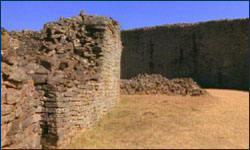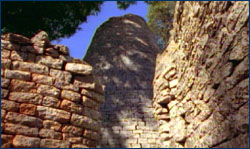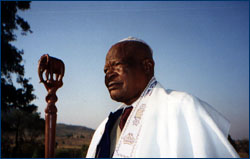
|

|
Part 2 | Back to Part 1 Contrite, the BSA hired archeologist David Randall-MacIver, protégé of the great Egyptologist Flinders Petrie, to investigate the site. Hall's polar opposite in almost every way, Randall-MacIver quickly concluded that former mud dwellings within the stone enclosures "are unquestionably African in every detail and belong to a period which is fixed by foreign imports as, in general, medieval." While MacIver's careful work set the stage for the sound archeological inquiry of Great Zimbabwe, racial prejudice surrounded the monument until quite recently. In the 1960s and 1970s, as the edifice grew into a potent symbol of the African Nationalist movement, the white government of Rhodesia set about suppressing the findings of prehistorians who claimed that Africans had built Great Zimbabwe. (Garlake, for one, was forced out of the country.) But those problems went away when Zimbabwe, as the country is known today, achieved majority rule two decades ago, and now we can look at Great Zimbabwe free of racial overtones. "Venerated houses" Many believe that "Zimbabwe" is a contraction of the Shona phrase dzimba dza mabwe, "houses of stone." (The Shona are Bantu people of Zimbabwe and southern Mozambique.) Garlake, for his part, feels the word more likely derives from dzimba woye, "venerated houses," a term usually reserved for chiefs' houses or graves. Either way, archeological investigation has shown that the edifice's monumental walls did once enclose houses. Great Zimbabwe was a city, home at its heyday to some 12,000 to 20,000 people. To this day, daga, a clayey conglomerate of gravel that is Africa's most common indigenous building material, still stains the soil within Great Zimbabwe a robust red color. While few traces of the mud houses remain, the towering stone walls stand in mute testimony to the city's former greatness. Quarried from the nearby granite hills, the rock used in the walls' construction easily split along fracture planes, giving the stones a cuboidal shape that lent itself to stacking without need of mortar. Ranging from four to 17 feet thick, Great Zimbabwe's walls are about twice as high as they are wide. This results in a very sturdy structure, which spreads its pressure evenly over the ground and adjusts well to subsidence. When two walls meet, they abut eachother with unbroken vertical joints; there are no interlocking stones. In the finest walls, workers knapped and dressed the stones so well that the coursing is as smooth as a modern brick wall.
While the site was occupied in ancient times—iron was in use there by the third century A.D.—its rise to prominence, and the advent of the finest walls, occurred in the 14th and 15th centuries during a great increase in trade. Great Zimbabwe happened to lie right on the route between the region's gold-producing regions and ports such as Sofala on the Mozambique coast, where merchants traded African gold and ivory for beads, cloth, and other goods from Arabia and farther east. The site may also have been a religious center, as evidenced by stone monoliths and "altars" found throughout the site, along with enigmatic soapstone birds and figures that, says Garlake, "point to the important role of ritual and symbol in the art and architecture of Great Zimbabwe." By the mid-15th century, however, the balance of trade had shifted to the north. Local resources had also apparently dwindled to dangerously low levels from overuse, and salt was scarce. Whatever the cause, Great Zimbabwe's people abandoned their once-glorious stone city, leaving the site a ruin that Mauch found 400 years later inhabited by local Karanga people who had no idea of its history. Mysteries Despite decades of study, mysteries still cling to Great Zimbabwe like ivy. How did its residents manage to monopolize trade in the area? To what degree was it a religious center? Why was it abandoned? Even the question that, as Garlake said about the site itself, "has given rise to such strong, widespread, and often bizarre emotional responses"—who built it?—has been only partly answered.
If the Lemba contention is true, does this mean that outsiders—that is, not native Africans—built Great Zimbabwe? After all, the Lemba have Semitic origins (see Tudor Parfitt's Remarkable Journey). The answer is no, because by the time Great Zimbabwe was built in medieval times, the Lemba had become decidedly African, having so thoroughly intermixed with Bantu Africans over many hundreds of years that today, among other African traits, the Lemba have dark skin and speak a Bantu language. Indeed, the more contentious part of that question "who built it" has finally been put to rest almost 450 years after João de Barros and others first propounded it. Whites did not build Great Zimbabwe, blacks did, and this fact only deepens the sense of mystery enveloping the site. As archeologist Gertrude Caton-Thompson declared back in 1931: Examination of all the existing evidence, gathered from every quarter, still can produce not one single item that is not in accordance with the claim of Bantu origin and medieval date. The interest in Zimbabwe and the allied ruins should, on this account, to all educated people be enhanced a hundred-fold; it enriches, not impoverishes, our wonderment at their remarkable achievement ... for the mystery of Zimbabwe is the mystery which lies in the still pulsating heart of native Africa. Peter Tyson is Online Producer of NOVA. Photos: Cicada Films Where are the Ten Lost Tribes? | Tudor Parfitt's Remarkable Journey Mystery of Great Zimbabwe | Build a Family Tree | Resources Teacher's Guide | Transcript | Site Map | Lost Tribes of Israel Home Editor's Picks | Previous Sites | Join Us/E-mail | TV/Web Schedule About NOVA | Teachers | Site Map | Shop | Jobs | Search | To print PBS Online | NOVA Online | WGBH © | Updated November 2000 |
 David Randall-MacIver, the first archeologist to
study Great Zimbabwe, declared it unequivocably of
African origin, with its heyday in medieval times.
David Randall-MacIver, the first archeologist to
study Great Zimbabwe, declared it unequivocably of
African origin, with its heyday in medieval times.
 Archeologists have determined that the Conical Tower
is completely solid; its purpose remains unknown.
Archeologists have determined that the Conical Tower
is completely solid; its purpose remains unknown.
 The Lemba, including Professor Mathiva, the tribe's
spiritual leader (above), believe that their ancestors
built Great Zimbabwe.
The Lemba, including Professor Mathiva, the tribe's
spiritual leader (above), believe that their ancestors
built Great Zimbabwe.